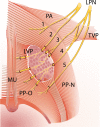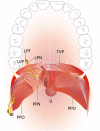The innervation of the soft palate muscles involved in cleft palate: a review of the literature
- PMID: 27020913
- PMCID: PMC4873542
- DOI: 10.1007/s00784-016-1791-6
The innervation of the soft palate muscles involved in cleft palate: a review of the literature
Abstract
Objective: Surgical techniques to obtain adequate soft palate repair in cleft palate patients elaborate on the muscle repair; however, there is little available information regarding the innervation of muscles. Improved insights into the innervation of the musculature will likely allow improvements in the repair of the cleft palate and subsequently decrease the incidence of velopharyngeal insufficiency. We performed a literature review focusing on recent advances in the understanding of soft palate muscle innervation.
Material and methods: The Medline and Embase databases were searched for anatomical studies concerning the innervation of the soft palate.
Results: Our literature review highlights the lack of accurate information about the innervation of the levator veli palatini and palatopharyngeus muscles. It is probable that the lesser palatine nerve and the pharyngeal plexus dually innervate the levator veli palatini and palatopharyngeus muscles. Nerves of the superior-extravelar part of the levator veli palatini and palatopharyngeus muscles enter the muscle form the lateral side. Subsequently, the lesser palatine nerve enters from the lateral side of the inferior-velar part of the levator veli palatini muscle. This knowledge could aid surgeons during reconstruction of the cleft musculature. The innervation of the tensor veli palatini muscle by a small branch of the mandibular nerve was confirmed in all studies.
Conclusion: Both the levator veli palatini and palatopharyngeus muscles receive motor fibres from the accessory nerve (through the vagus nerve and the glossopharyngeal nerve) and also the lesser palatine nerve. A small branch of the mandibular nerve innervates the tensor veli palatini muscle.
Clinical relevance: Knowledge about these nerves could aid the cleft surgeon to perform a more careful dissection of the lateral side of the musculature.
Keywords: Glossopharyngeal nerve; Lesser palatine nerve; Levator veli palatini; Palatopharyngeus; Pharyngeal plexus; Tensor veli palatini; Vagus nerve.
Figures



Similar articles
-
Three-Dimensional Anatomy of the Palatopharyngeus and Its Relation to the Levator Veli Palatini Based on Micro-Computed Tomography.Plast Reconstr Surg. 2021 Sep 1;148(3):389e-397e. doi: 10.1097/PRS.0000000000008275. Plast Reconstr Surg. 2021. PMID: 34432689
-
Three-dimensional finite element analysis on stress distribution after different palatoplasty and levator veli palatini muscle reconstruction.Clin Oral Investig. 2024 Mar 19;28(4):221. doi: 10.1007/s00784-024-05583-9. Clin Oral Investig. 2024. PMID: 38499908
-
Nerve supply to the soft palate muscles with special reference to the distribution of the lesser palatine nerve.Cleft Palate Craniofac J. 2005 Sep;42(5):495-500. doi: 10.1597/04-142r.1. Cleft Palate Craniofac J. 2005. PMID: 16149830
-
The role of the tensor veli palatini muscle in the development of cleft palate-associated middle ear problems.Clin Oral Investig. 2016 Sep;20(7):1389-401. doi: 10.1007/s00784-016-1828-x. Epub 2016 May 7. Clin Oral Investig. 2016. PMID: 27153847 Free PMC article. Review.
-
Cleft Palate.Clin Plast Surg. 2025 Apr;52(2):157-177. doi: 10.1016/j.cps.2024.10.001. Epub 2025 Jan 18. Clin Plast Surg. 2025. PMID: 39986880 Review.
Cited by
-
Effect of Dissection and Reconstruction of Palatal Muscles on Morphological Features and Ultrastructure of the Oral Musculature in Cats.Biomed Res Int. 2016;2016:6807678. doi: 10.1155/2016/6807678. Epub 2016 Sep 6. Biomed Res Int. 2016. PMID: 27699171 Free PMC article.
-
Functional cleft palate surgery.J Oral Biol Craniofac Res. 2023 Mar-Apr;13(2):290-298. doi: 10.1016/j.jobcr.2023.02.003. Epub 2023 Mar 1. J Oral Biol Craniofac Res. 2023. PMID: 36911175 Free PMC article.
References
Publication types
MeSH terms
LinkOut - more resources
Full Text Sources
Other Literature Sources
Medical

